What Is Conversational Marketing?
Conversational Marketing is a dialogue-driven approach to marketing that uses real-time conversations to engage site visitors and quickly move them through the buying journey. It creates an authentic experience that builds relationships with customers and buyers.
Drift created the Conversational Marketing category because we saw how the traditional B2B sales process alienated buyers — even though buyers were the ones now calling the shots.
So instead of forcing people to go through lead capture forms and wait days for a response, we built a Conversational Marketing platform that uses targeted messaging and intelligent chatbots to engage with people when they’re on your website.
Making it easier for people to engage with your business will help you convert more of the right leads faster. Which means happier customers and a happier company.
How Conversational Marketing Is Changing the Way Your Customers Buy
There’s a problem with the way we’ve been taught to market and sell—it no longer matches how buyers buy things.
Think about it—when you’re not talking to someone face-to-face, where do most of your conversations happen? For most people, the answer looks a lot like this:

People love communicating with messaging because it’s fast, easy, and actually feels like a conversation. So it’s not surprising that, in 2021, some of the most popular communication channels included online live chat (61%), phone and/or video call (58%), and email (50%).
But most businesses are still forcing people to jump through endless hoops before a conversation takes place.
Here’s how the traditional funnel works these days:
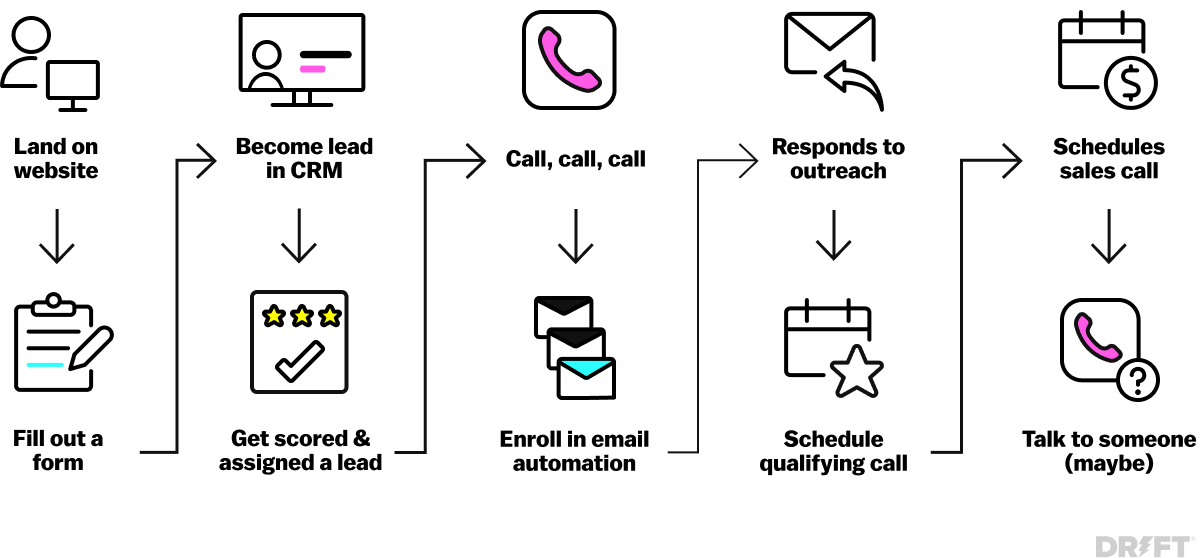
Buyers and customers don’t have time for this anymore, and the numbers show it:
- 27% more B2B buyers expressed frustration with old school forms in 2021 than in 2020.
- Email usage has dropped by 25% since 2020.
- The demand for immediacy has grown by an average of 64% year-over-year.
The B2B buying process has become cold, impersonal, and way more painful for the buyer than it needs to be.
The fix?
We need to make business actually feel personal again.
Conversational marketing builds relationships and creates authentic experiences with customers and buyers.
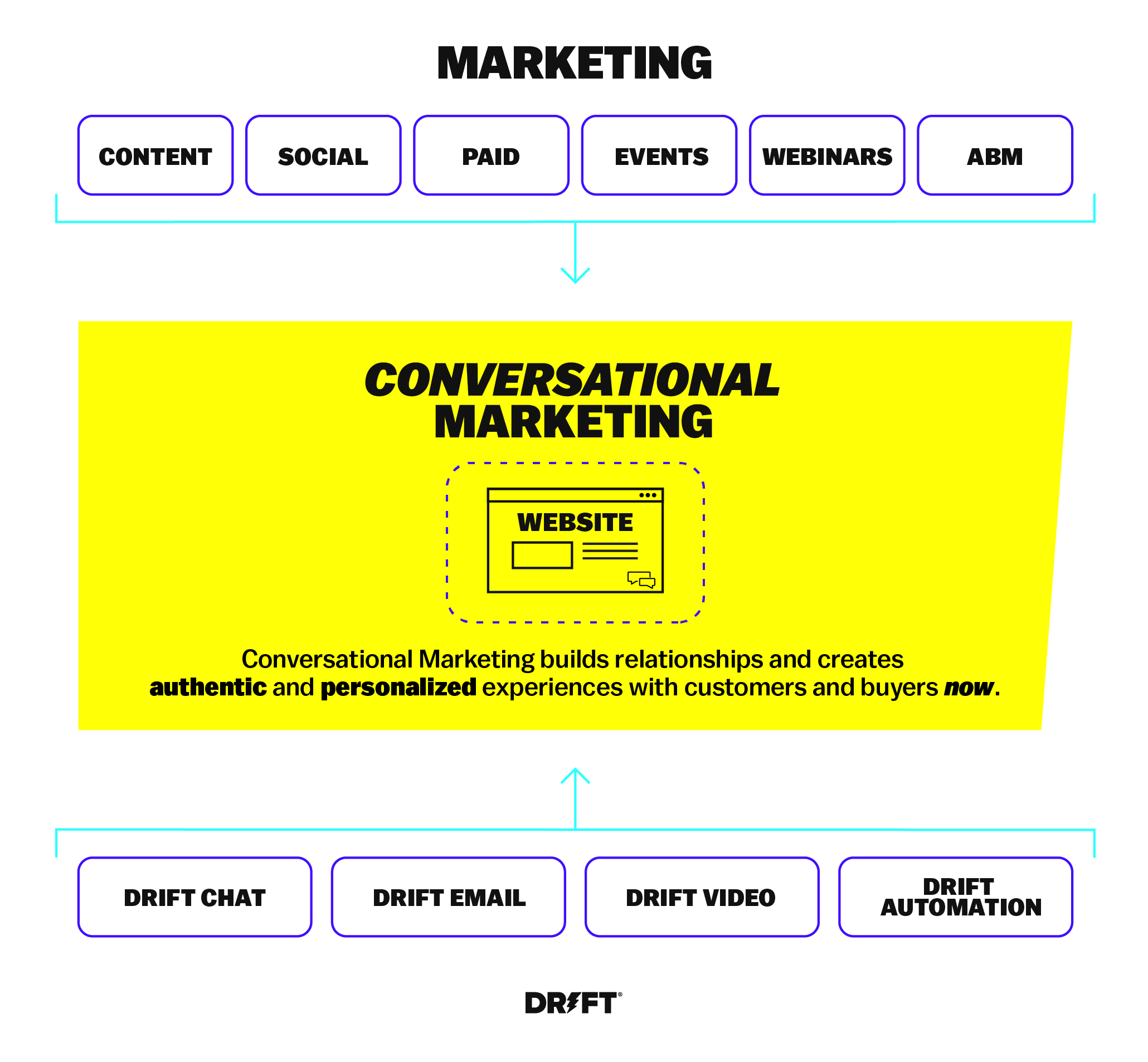
How Do You (actually) Do Conversational Marketing?
Implementing Conversational Marketing doesn’t force you to blow everything up and start from scratch.
It’s more like turning on a new lead generation channel that complements your existing marketing efforts. We boiled it down into a simple framework called the Conversational Framework. It consists of three steps:
- Engage
- Understand
- Recommend
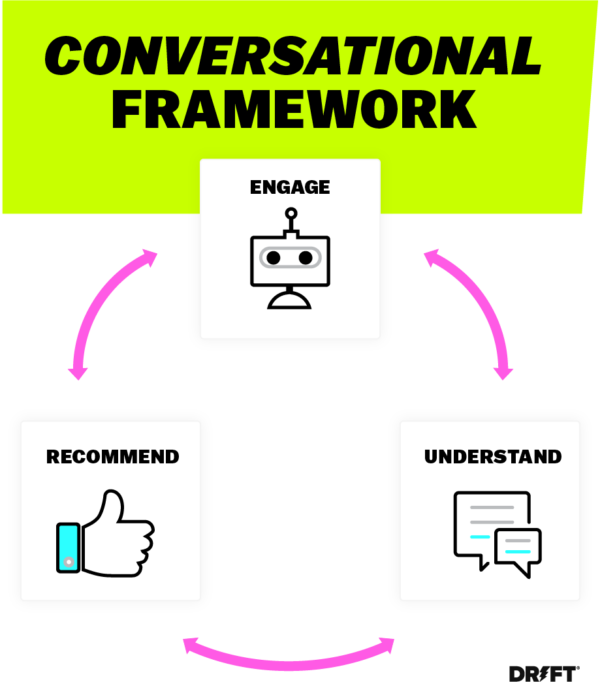
The Conversational Framework isn’t a new marketing and sales funnel. It’s a way to have conversations, build relationships, and move people through the funnel you already have.
Let’s break down each step.
Step 1: Engage More Leads with Chat Instead of Forms
What happens when you give visitors ways to instantly start conversations on your website instead of forcing them to fill out forms? For most businesses, it means higher conversion rates, more opportunities, and a more personal experience with the customer.
With Conversational Marketing, when a visitor clicks download, contact sales, or book a demo, you want to immediately jumpstart the conversation. From there, you can move people through your funnel instead of forcing them to wait for a follow-up email — as long as that’s what they want.

Of course, you can’t have someone operating your live chat 24/7. That’s why we built intelligent chatbots that make Conversational Marketing work for your business no matter the time of day. Now, you can engage people on your website when they want to engage with you.
You can also send targeted messages to the visitors who seem most likely to buy instead of waiting for them to initiate the conversation. Whether you want to offer assistance to people browsing your pricing page or check in on repeat visitors, with Drift, you can proactively reach out to the people who are serious about buying.
Step 2: Understand Leads and What They Want in Minutes Instead of Days
In the typical qualification process, qualifying a lead can take days.
But according to a study from Harvard Business Review, companies need to respond within five minutes of initial contact to have the best chance of qualifying a lead. Wait any longer and your odds of qualifying the lead decrease by 400%.
With Conversational Marketing, bots keep you available 24/7 to engage with new leads instantly. Chatbot platforms can understand who those visitors are and what they want by qualifying those leads in real-time.
Build your bot using questions similar to the ones you ask on forms or qualifying calls. The bot will then have a conversation with the lead to understand them better and recommend the best next step for them. By doing this, you’ll speed up response times and ensure your sales rep jump in with the right people at the right time.
Ready to accelerate your revenue with Conversational Marketing?
Bots also understand who might not be ready for a sales conversation and can disqualify visitors, saving your reps valuable time. Drift’s chatbots can deliver resources to unqualified visitors and help customers looking for support without eating into your sales reps’ time.
Step 3: Recommend the Right Next Step to Move Leads Through Your Funnel
Bots are great at engaging and understanding leads, but nothing beats human-to-human interaction once it’s time to close the sale. That’s why bots use intelligent routing to connect leads to your sales team and automatically book meetings for them — so your reps can focus on selling.
With intelligent routing, bots will always make sure the right leads go to the right reps. If you have multiple reps in the same territory, leads can be assigned on a rotational basis.
Once sales reps connect their calendars, bots can book meetings for qualified leads directly from the chat. Your sales team will appreciate waking up to calendars full of high-quality meetings.
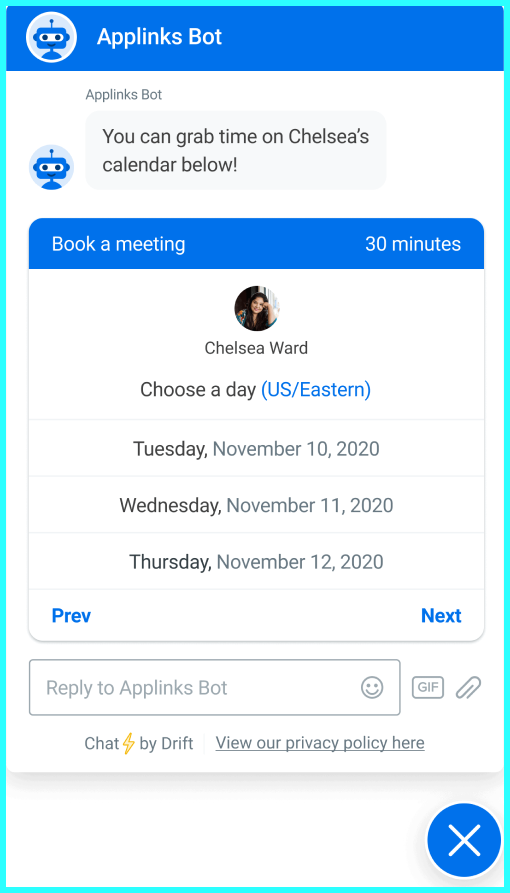
If someone isn’t ready for a meeting, the bot can provide resources to answer their questions or suggest personalized solutions. And they can nurture leads to the next stage by further qualifying them and delivering relevant content over time. This is one of the key differences between Conversational Marketing and traditional inbound marketing 👇
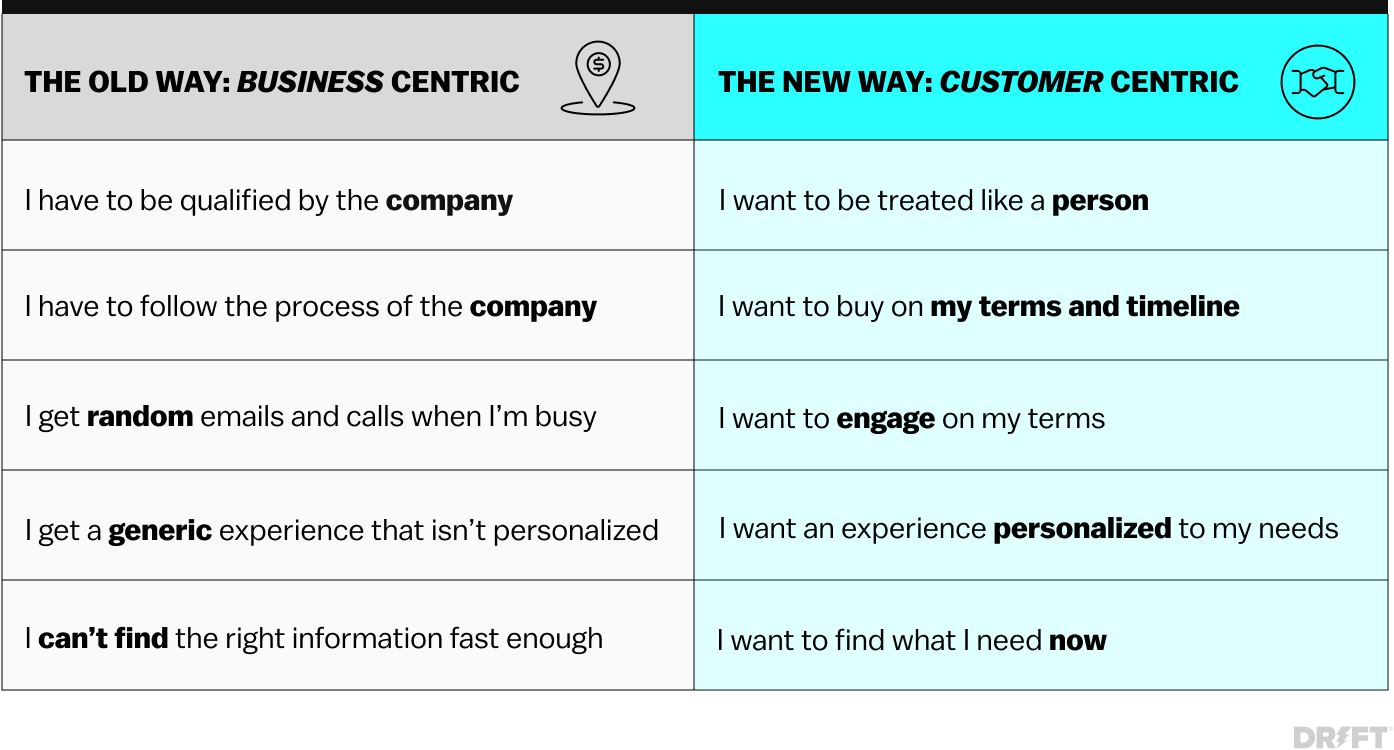
The 6 Key Benefits of Conversational Marketing
You’ve already read about some of the positive results many different businesses have been able to achieve through Conversational Marketing. But those aren’t the only benefits you can expect.
Here are the six biggest benefits of using conversations to capture and qualify leads:
1. You create a more human buying experience
Even as B2B buying has become more digital, buyers still crave real-time interactions. With a Conversational Marketing software in place, your website no longer feels like an empty store without salespeople.
Now, you can actually say “hello” to the people taking the time to visit your site, allowing them to start a conversation when it’s most convenient for them. Through a positive site experience, you can build trust with your buyers so that, when it comes time to buy, you’ll be the first to come to mind.
2. You learn a ton about your buyers and customers
Lead forms are good for collecting contact info, but they’re not great at providing context. On the other hand, in a conversation, you can easily delve into why a buyer came to your site, what their biggest pain points are, and which product features are most important to them. Plus, you won’t have to second-guess whether a lead fits your ideal customer profile or is actually looking for support — you’ll know by the end of the conversation.
3. You convert more leads and better leads
81% of tech buyers who encounter gated content simply decide not to download it. Conversations can help you engage with these buyers who never would have filled out a lead form. That’s how global cybersecurity and compliance company Proofpoint saw a 147% increase in website visitor email submissions and a 578% increase in chat-sourced opportunities.
Chatbots can also help you pinpoint target accounts as well as visitors who have high intent to buy so that your sales team can focus their time and effort on those conversations.
4. You deliver personalized recommendations for site visitors
No two buyers are the same — and a conversational experience allows you to build on that. Instead of dropping unqualified leads or people who aren’t ready to buy, your chatbots can deliver relevant resources or work on nurturing those visitors to the next stage.
You can also draw on insights from your conversations to better tailor the buying journey for qualified leads. This is especially useful for uncovering opportunities to cross-sell and upsell to existing customers.
5. You shorten your sales cycle
Leads qualified through conversations — called conversation qualified leads (CQLs) — tend to close faster than leads qualified through traditional methods.
Using Drift, HR management company Zenefits was able to shorten their sales cycle from more than six months to as short as 12 days.
6. You help sales close more deals efficiently
Chatbots are prepared to engage with site visitors 24/7 — whether they are an executive from a target account or a completely new lead. This means that no opportunity will slip past you.
Intelligent routing also makes it easy for your sales team to jump into the conversation at the right time and with the right people, allowing them to focus on closing deals. Over the course of one year, SAP Concur saw their conversations lead to more than $10M in attributed pipeline.
Ready to Make Conversational Marketing Work for You?
Conversational Marketing Examples
Now that you know what Conversational Marketing is, how it works, and what benefits it offers, you’re probably wondering what it looks like in practice. While Conversational Marketing isn’t exclusive to live chat and chatbots, we wanted to showcase what a conversational approach looks like — at every stage of the buying journey.
Here are three examples from our collection of really good chatbots:
1. Gong’s Engage All Chatbot
At the beginning of your Conversational Marketing journey, you want to create a chatbot that is ready to engage with all site visitors and help each of them find what they are looking for. Gong does this with their Engage All chatbot:
This bot starts off by engaging the site visitor with a cheeky hook. Then, it asks some follow-up questions to understand why the visitor is on their site. Finally, the bot recommends either a meeting with sales or best practice content, depending on whether they are a good fit for Gong.
2. Brandwatch’s Persona Targeting Chatbot
Once you’ve successfully built several chatbots that engage site visitors, you want to create personalized playbooks to increase engagement and qualified pipeline. Brandwatch does this using a custom playbook on one of their industry pages:
The bot engages the visitor by acknowledging a specific pain point and offering the chance to speak with an expert. It does this because it understands that the visitor is further along in the buying journey as they are looking at industry-specific solutions. That’s why the bot recommends a conversation with sales upfront.
3. Okta’s Return Visitor Chatbot
To create an even more personalized experience, you want to set up chatbots that personalize every step of the buying journey to shorten sales cycles and close more revenue. Okta does this with their Return Visitor chatbot:
This AI-enabled chatbot is designed to engage with return visitors using a custom hook. Then, the bot tries to understand by giving the visitor several chat button options, as well as allowing them to simply type in what they want. Lastly, the bot recommends a meeting with sales along with other resources for those not ready to chat.
Conversational Marketing FAQ
Here are the most common questions we get related to Conversational Marketing:
Do I have to completely remove all of my lead capture forms?
No. Getting started with Conversational Marketing isn’t an “all or nothing” decision. Rather than removing all forms from your site, you could start by adding live chat and chatbots as a second net — an alternative to forms for leads who are ready to talk to someone immediately. That will open a new way for your prospects to engage with you that’s more natural and personal.
How do I measure the effectiveness of Conversational Marketing?
Drift’s Conversational Marketing platform gives you dashboards that show you how many leads you’ve captured and qualified with conversations, how many meetings you booked and scheduled, and how much revenue and pipeline your conversations are driving. You can even see the total amount of sales opportunities influenced.
Can I use Conversational Marketing and chatbots for customer support?
Yes! Drift Conversational Service helps reduce the friction of customer support experiences by empowering customers to find answers to their questions on their own and get help from a customer support rep without having to wait.
Looking for an example of how you can use Conversational Service? Check out our knowledge base which holds our help docs and is guided by our customer support bot.
How do I scale Conversational Marketing?
Bots allow you to offer fast responses to visitors 24/7, even while your team is sleeping. Since they can ask the same qualifying questions your sales reps normally would, they can figure out who’s qualified to talk to sales and connect them to the right person.
Chatbots have become so effective at these types of conversations that they now manage over 50% of all the conversations we have at Drift.
